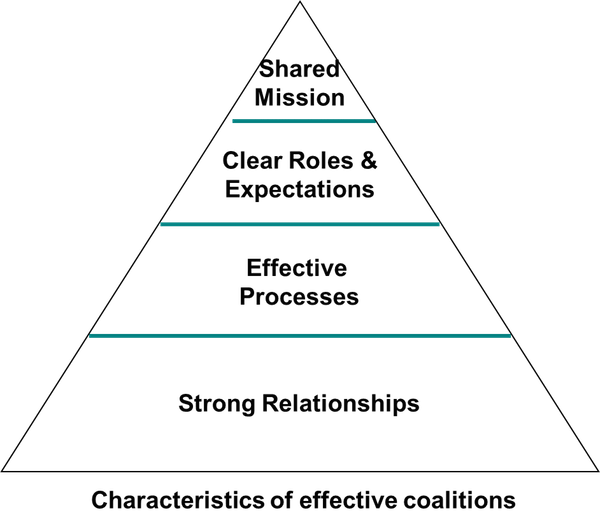Hi, my name is Courtney Barnard and I am a social worker at a children’s health care system in north Texas. I spend half my time out in the community coordinating a coalition and the other half evaluating seven other community-based coalitions and programs.
You can use evaluation to help plan for the sustained impact of a coalition’s efforts. The long-term goal is not always to sustain the coalition itself, or even its main activities, but to sustain the change in knowledge, attitudes, skills, and behaviors that have occurred because of the community’s work.
Our sustainability plans are based on three core concepts of sustainability, as outlined by Monte Roulier with Community Initiatives Network.
Hot Tip: Begin the sustainability conversation with a visioning activity, using this prompt: “Imagine that it is [three years in the future] and your coalition has been extraordinarily effective for the past three years. Write a letter to a colleague describing what’s now going on as a result of a fruitful past 3 years.”
- Building an effective coalition and “backbone” support – Successful coalitions share a common vision based on mutual benefits and prioritized strategies and outcomes aimed at shared goals. A strong backbone is needed to guide the group in articulating their goals and in planning how they will get there.
Lessons Learned: Backbone supports are able to offer structure (e.g. bylaws, coordinators), lead strategic planning processes, and engage others in the community. Although this structure takes time to develop, it is essential for long-term functioning.
- Employing the right mix of strategies – Use easily-achievable actions to engage members and build momentum. These quick wins will help the coalition spring board into longer-term, more complex actions.
Rad Resource: Use the Spectrum of Prevention from the Prevention Institute to assess where your strategies fit. If your coalition chooses not to take action at one of the levels, make sure someone else in the community is acting on that level.
Hot Tip: Use this “formula” for Impact when prioritizing strategies/action steps to see how you can get the biggest bang for your buck.
- Securing diverse resources – Braid and pool separate sources of funding when possible and leverage non-financial resources (communication, staff, volunteers, office space, food, research, fiscal management, etc.).
Lessons Learned: Make your propositions compelling so no one can say “no”. Be clear and specific about real needs. Demonstrate results and your plan for future outcomes. And frequently praise contributors, no matter how small the contribution.
The American Evaluation Association is celebrating CP TIG Week with our colleagues in the Community Psychology Topical Interest Group. The contributions all week come from CP TIG members. Do you have questions, concerns, kudos, or content to extend this aea365 contribution? Please add them in the comments section for this post on the aea365 webpage so that we may enrich our community of practice. Would you like to submit an aea365 Tip? Please send a note of interest to aea365@eval.org. aea365 is sponsored by the American Evaluation Association and provides a Tip-a-Day by and for evaluators.



This was such a great read! Thanks for the tips!